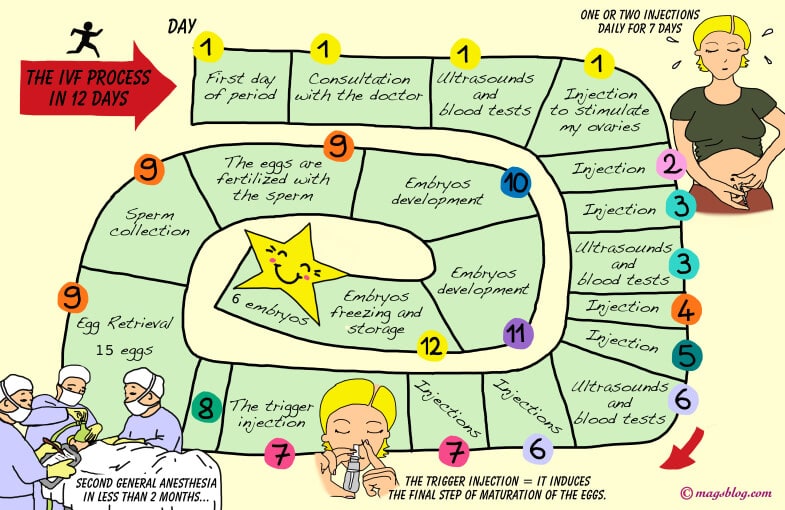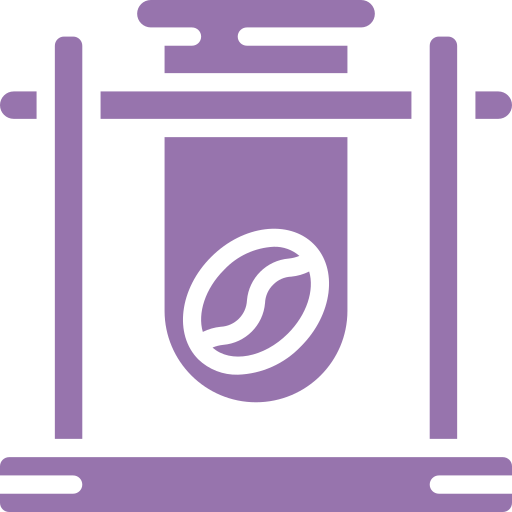
IVF Timeline

Suppression and Developing Eggs
- The first part of the IVF process timeline starts on the day the woman starts her period. During the first phase of the IVF cycle timeline, the woman takes birth control pills to regulate hormones and synchronize the timing of the other drugs.
- On day 21 of her menstrual cycle she also starts taking Lupron, the stimulation medication, for 10 days. Lupron acts on the part of your brain (pituitary gland) that stimulates the ovary but also suppress the ovary from ovulating. This way, the ovaries ripen multiple follicles, instead of the single one during the natural cycle.
- After 10 days of Lupron, a suppression check is done to make sure ovulation has been suppressed.
- At this point, the woman starts to take ovary stimulation medication. The most common injectable meds are Follistim, Menopur, Gonal-F, Bravelle, and Repronex. During this part of the IVF procedure timeline, the woman will still be taking Lupron but the dose will be continually lowered. The stimulation period last 8-12 days.
- During the stimulation period the woman will undergo frequent ultrasound and blood tests. These tests are to determine when the biggest follicles get to 18-22 millimeters in diameter. This is the ideal size for the follicles, when they get to this size they are mature and ready to be harvested.
Ready for the Egg Retrieval
Exactly 36 hours before the planned egg retrieval the woman receives an injection of human chorionic gonadotropin (HCG) to stimulate the eggs’ release from the walls of the follicles. This is called the trigger shot and the timing on this shot is critical. The eggs will release 40 hours after the shot is given, so they need to be harvested before they leave the ovary. If the shot is given too early the eggs could already be in the fallopian tube where they would be impossible to harvest.
Egg Retrieval
The egg retrieval part of the IVF procedure timeline is a minor outpatient surgical procedure that usually takes around 30 minutes. Because the timing of the procedure is so critical, this procedure is scheduled before the HCG shot so it can be synchronized properly. If the sperm being used is from the woman’s partner, he usually donates on the day of the egg retrieval. Once the eggs are retrieved, they are taken to the lab where they are graded and tested. This is done so the fertility center knows how many viable eggs they are working with.
Fertilization
Shortly after the eggs are retrieved and graded, or frozen eggs are thawed, they are fertilized. In about half of IVF cycles the egg are fertilized by putting them in a dish of sperm. In rest of the IVF cycles the eggs are fertilized using the Intracytoplasmic sperm injection (ICSI) procedure, where a single sperm is injected directly into the egg. This procedure is especially useful when there are problems with the sperm because only one healthy sperm is required.
Developing the Embryos
After the embryos are created they are developed in the lab for 3-6 days.
- First 3 days the embryos grow in a culture media that is designed to mimic the fluid in the fallopian tubes. Then the embryos are transferred to different culture media, which is formulated to mimic the uterine environment.
- Day 4-6, the lab offers extended embryo culture to grow them to the blastocyst stage.
- Transferring blastocyst stage embryos offer several advantages over the day 2–3 transfer embryos – day 3 embryos should have already started dividing, but only have 6–8 cells. Blastocyst stage (day 5–6) have 80–120 cells. By seeing the difference in the quality of embryos the doctors can transfer the strongest and ensure the best possible outcome.
Another advantage of blastocyst stage embryos is that Pre-implantation Genetic Diagnosis (PGD) can be performed. This test is similar to the screening run during the pregnancy, a genetic screening to rule out some genetic disorder.
Preparing the Uterine Lining
The day after the eggs are retrieved the woman starts daily injections of progesterone to enrich the uterine lining and prepare it for incoming embryos. This supplementation continues for the first 2-3 weeks after the embryo transfer.
Transferring Embryo(s)
The embryo transfer procedure very similar to Intrauterine insemination (IUI). The procedure is done in a doctor’s office, last about 15–20 minutes, and doesn’t require anesthesia. The doctor will insert a very small, thin and flexible catheter through the cervix. The embryo(s) that are going to be implanted are delivered directly into the uterus where they attach. After the procedure, the woman rest for at least 30 minutes then is free to go home.
Taking the Pregnancy Test
Usually 11–14 days after the transfer date the woman takes a pregnancy test, generally a blood test since they’re more accurate. That’s the IVF timeline from start to finish but it isn’t really the finish of anything. What it means is the start of a lifetime full of the joys of parenthood.
The IVF timeline treatment cost of $20,000 per conventional cycle it makes sense to be aware of the IVF timeline. It’s important to schedule IVF procedures during a time when the woman will be available for the appointments and have someone to drive her to the egg retrieval. 4-6 weeks of appointments is a small price to pay for the opportunity to have a family of your own.


















